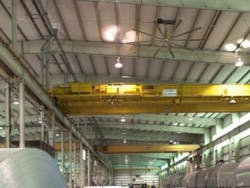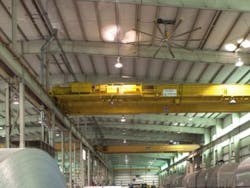How Air Movement Improves Processes and People
“We’ve got 60 machines in this shop, each one venting air at about 110 F, so we have a lot of difficulty getting the place cool,” says EMS Controller Charles Stanford. “Complaints were just a daily event around here, and it was understandable.”
In lieu of adding additional tonnage to their existing AC system to the tune of $100,000 to $150,000, EMS installed three 16-ft. large diameter fans which work to distribute the conditioned air and disturb the pockets of hot air around the machines to get a more uniform temperature along with a breeze around the employees.
Employees felt the benefits of the fans and can now focus on the task at hand rather than their discomfort.
The Benefits of Air Movement
The addition of air movement can:
∙ Reduce heat stress on employees;
∙ Reduce condensation to preserve product integrity and improve safety;
∙ Improve indoor environmental quality (IEQ);
∙ Provide year-round environmental consistency.
An unfortunate reality of warehouse design is that supply chain facilities are prone to fluctuating temperatures. Ventilation systems and air conditioning, where present, are effective to a certain extent, but can be greatly enhanced by the addition of proper air movement. When interior conditions are such that workers can no longer concentrate on the job at hand, personal comfort must be addressed.
Comfort and Productivity
When temperature and humidity rise, the body’s ability to cool itself decreases, severely affecting worker productivity. OSHA standards indicate temperatures of 100.4° F and above are dangerous for workers while air temperatures that exceed 95° F significantly increase the heat load on the body.[i]
According to the Center for the Built Environment, temperature and air quality are two of the most important factors when considering productivity[ii]. Studies indicate that worker productivity drops by 2% for every 1.8° F rise in temperature above 77° F.
Inthe manufacturing, reducing the activity level or adding air conditioning are generally not options, but applying gentle, non-disruptive airflow from large diameter, low speed fans can make workers feel up to 10° F cooler.
Process Modifications
The addition of large overhead fans can also speed drying processes and reduce rusting issues in various plants. These cover a range of industries, from pallet manufacturing to brickmaking, painting and even water jet cutting.
Owensboro Brick & Tile produces 30 to 35 million bricks every year. The staging area holds 300,000 to 400,000 bricks at a time while they dry out before going into the 1950° F kiln. Plant manager Mark Sexton first faced this challenge when he noticed green bricks were coated with a fine layer of slick water and clay, increasing drying time and slowing production.
“We have to get a certain percentage of moisture out of the brick before we can fire it,” explains Sexton. As one set of bricks would come out of the kiln, the steam they let off would keep the area hot and perpetually wet.
Upon the installation of four 16-ft. diameter fans, air speed in the drying area increased, helping aid the evaporation of moisture from the green bricks waiting to be fired, while also dissipating heat and moisture from the steaming bricks coming out of the kiln.
“These fans are really helping the dryer out, to get the moisture out of the brick,” Sexton states. “I can run our kilns a little faster to get more product out, because the bricks are drier.”
Packaging Improvement
Exemplary Foam of Elkhart, Ind., uses high-pressure water jets to cut blocks of dense, closed-cell foam into reusable packaging for engine components and other heavy-duty uses. But there’s a downside to this versatile cutting approach—droplets of water remain on the finished foam. Shipping wet foam causes cardboard boxes to deform, or even freeze in the winter. Rather than waiting for the foam to dry of its own accord, Exemplary Foam added industrial-duty large mobile fans to its production area.
“Compared to just sitting there and waiting for them to dry, it’s definitely faster with the fans,” explained Operations Manager Stacey McKee. “We put the foam in wire baskets and put the fans around it. Or sometimes it gets to the point that to get it dry, we literally just make a big mountain of it on the floor and surround it with fans.”
Conclusion
Incorporating large diameter, low speed fans can help operations improve employee comfort, productivity, indoor air quality and product integrity.
Megan Browning is a writer for Big Ass Fans.
[i]Occupational Health and Safety Administration Technical Manual, Section III: Ch. 4; Heat Stress. 1999
[ii]Center for the Built Environment. “TechNotes: Productivity and IEQ Satisfaction.”
[iii]Occupational Health and Safety Administration Technical Manual, Section III: Ch. 4; Heat Stress. 1999
[iv]Center for the Built Environment. “TechNotes: Productivity and IEQ Satisfaction.”

